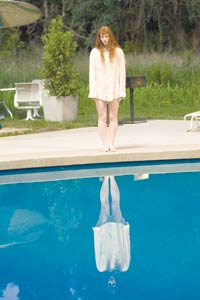Has M. Night Shyamalan lost his goddamn mind?

That’s the only logical excuse for Lady in the Water, the Philly-based writer/director/egomaniac’s convulsive seizure of narcissism that’s so nakedly personal—and also so unintentionally, hilariously revealing—watching the movie feels a bit like walking in on your roommate while he’s masturbating … to a picture of himself.
Billed as “a bedtime story by M. Night Shyamalan,” the film takes place entirely inside a run-down apartment complex, where Paul Giamatti’s Cleveland Heep (the names in this movie are really something else) is the depressed, stuttering superintendent. There’s a Rainbow Coalition cast of self-consciously “wacky” characters dwelling in their separate units just above the poverty line. And then one day a mermaid shows up in the swimming pool.
Well, not a mermaid per se. She’s a “narf”—some sort of sea nymph who can see into the future, and is visiting here from “the blue world” to help “man get back on the right path.” Played by Bryce Dallas Howard in a joyless Osment-ian whisper, our narf is really more of a wet blanket, quivering in Giamatti’s shower most of the time and gravely intoning ominous prophecies. Oh wait, did I forget to mention her name is “Story”?
Story has been sent to this particular pool so she may serve as a muse to a brilliant young writer—a young man so exceptional, with ideas so powerful, an entire generation is going to take his words to heart—and thanks to the fine work of this astounding young genius, our ravaged, war-torn earth will be returned to paradise.
The brilliant young writer is portrayed by M. Night Shyamalan.
Poor Story didn’t cross into our world alone—there seem to be several snarling hellhounds on her trail. These creatures are called “scrunts,” which I believe is a word I once heard in a completely different context on The Howard Stern Show. It falls on Cleveland to rally all the rascally residents to perform a complex nonsense ritual that’ll somehow enable a giant eagle to swoop down from the heavens and bring the ailing Story back home—all while keeping those nasty scrunts at bay.
What’s remarkable—and dramatically deadening—is that everybody cheerfully goes along with this silliness, grinning beatifically and spouting affirmative aphorisms about accepting their destinies. Shyamalan clearly wants to make a parable about the importance of faith (territory he already mined in his far superior Signs) and the value of a community working together toward a positive goal.
The trouble is he’s put it together so hamfistedly, with such overwrought, cringe-worthy dialogue, you’ll half wonder if he’s going to pull one of his patented twist endings and reveal the entire apartment complex is actually an insane asylum.
Also, it doesn’t help that the positive goal he’s assigned to this makeshift community involves protecting and nurturing the genius of M. Night Shyamalan.
Even more embarrassing is that the only note of skepticism from any of the residents comes from a pissy film critic played by Bob Balaban. Perhaps intended as some sort of cathartic payback for the savage reviews given to Shyamalan’s The Village (and probably as an inoculation against the even harsher ones Lady in the Water is bound to receive), the scrunts rip the guy to shreds.
Shyamalan knows how to put a film together. Even The Village is one of the most elegantly crafted stupid movies you’ll ever see. But his locked-down camera and church silences are a terrible match for this script’s loosy-goosey mythological musings. If something this extraordinarily asinine were ever going to have a chance of working, it needed to be joyful and light on its feet. Lady in the Water sags under the usual M. Night hush, with leaden pauses between every whispered line.
Somewhere in the middle of this foolish thing, Story peers into the future (perhaps looking ahead to the derisive cackles at my screening) and informs Shyamalan that he’ll one day be martyred for his writing, but it’s okay because his work is still going to reach people, and the power of his ideas will change the world.
You know, even Shyamalan’s buddy Mel Gibson had enough common sense not to cast himself as Jesus.
Once in a Lifetime In the 1920s Philly was a soccer town. And so was pretty much every industrial city in northeastern America. Alas, the Depression and the vile machinations of the bastards who ran baseball all but killed this most American of sports. By the time the game was revived in the 1960s in the shape of the North American Soccer League, confused yanks shrieked that soccer was un-American, a game for “communists and pansies.” After briefly sketching soccer’s glorious American history, this artfully edited and often hilarious documentary fast-forwards to 1977—the year punk broke and America once again fell in love with the beautiful game. The story really starts with the Brazilian superstar Pelé, lured to the New York Cosmos, being heckled at a jampacked and frenzied press conference by legendary sports writer Dick Young. He barked that Pelé would “destroy baseball.” This is a crazy story about crazy times—20,000 Philadelphians turned up to a Cosmos game just to watch Pelé hobble on crutches on the sidelines. The Brazilian was soon joined in New York by other world-famous superstars. Other clubs frenziedly scrabbled to compete, creating a bidding frenzy. But the film really focuses on New York. Bankrupt, blacked-out, riddled with heroin and stalked by the Son of Sam, New York in the 1970s was the decadent disco/punk capital of the entire world—the city where shit happened first. And the savagely partying Cosmos ruled the city. Henry Kissinger, Mick Jagger and Andy Warhol all have walk-on parts, but the stars of this story are the Cosmos themselves. Enormous egos clashed on and off the field, and to see these men—now middle-aged but still furiously embittered—verbally hack each other into bloody chunks is even more exhilarating than the breathtaking soccer footage. Eventually the Cosmos—and, so it seemed, U.S. soccer—imploded. But Once in a Lifetime quite rightly ends on a high note. The USA hasn’t returned to its previous amnesiac soccer-phobic state. All those free balls given out all over the country—all those dreams inspired by Pelé—took root and have flourished into the most populous, dynamic and exciting grassroots soccer scene on the planet.
The U.S. is once again a soccer nation. |
||||||||||||||
|
||||||||||||||
